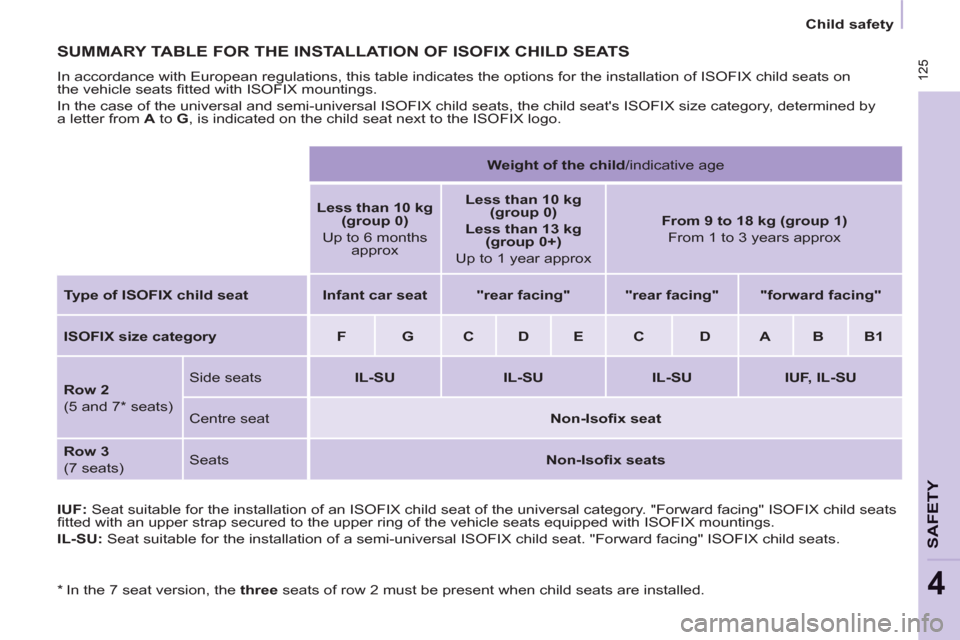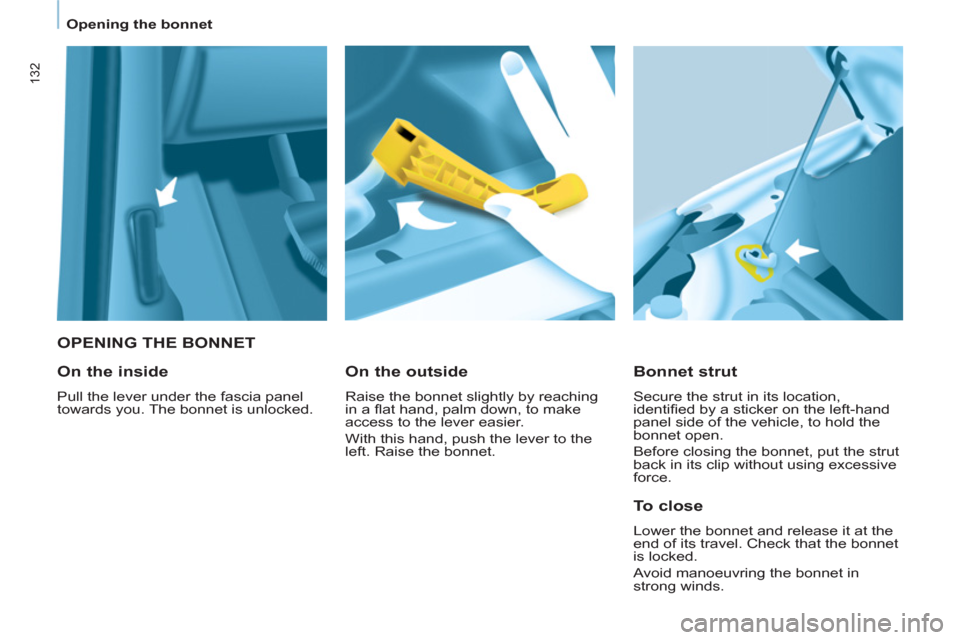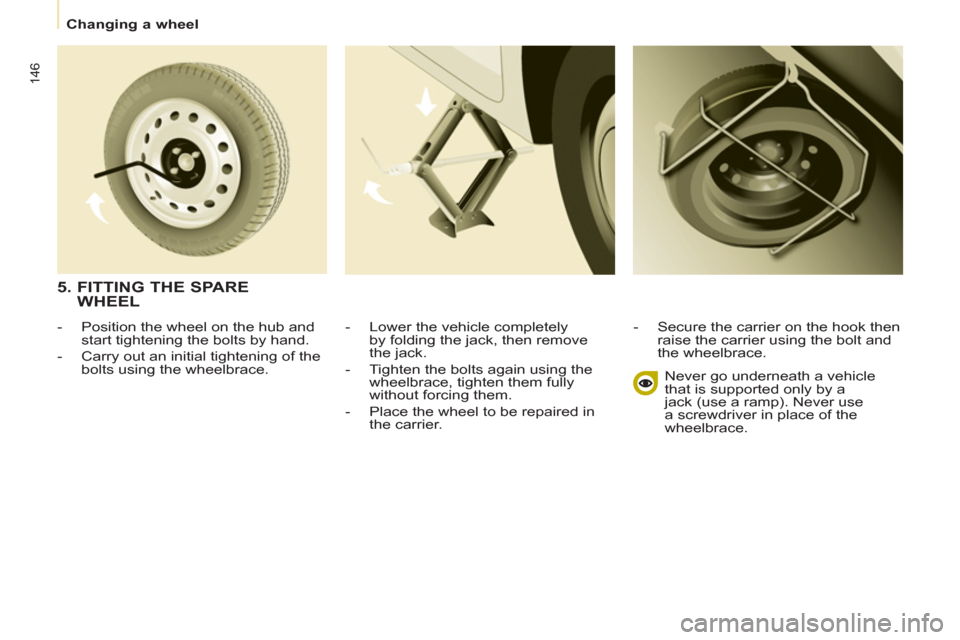2011 Peugeot Partner Tepee ECU
[x] Cancel search: ECUPage 124 of 232

122 122
Child safety
INSTALLING CHILD SEATS ATTACHED USING THE SEAT BELT
In accordance with European regulations, this table indicates the options for installing child seats secured using a seat belt
and universally approved in accordance with the weight of the child and the seat in the vehicle.
a: Group 0: from birth to 10 kg.
b: consult the legislation in force in your country before installing your child on this seat.
c: if the seats in row 3 are occupied, do not leave a child seat installed on the foldable row 2 seat, to allow easy access to row 3.
d: the head restraints of the seats in row 2 and row 3 must be removed for more secure fi tting of the child seat.
U: seat suitable for the installation of a child seat secured using a seat belt and universally approved, "rear facing" and/or
"forward facing".
Seat(s)
Weight of the child and indicative age
Under 13 kg
(groups 0 (a)
and 0+)
Up to approx
1 year
From 9 to 18 kg
(group 1)
1 to 3 years
approx
From 15 to
25 kg
(group 2)
3 to 6 years
approx
From 22 to
36 kg
(group 3)
6 to 10 years
approx
Row 1 (b) Passenger
seat
U
U
U
U
Row 2 (d)
(5 and 7 seats) Side seats
U
U
U
U
Centre seat
U
U
U
U
Row 3 (c, d)
(7 seats)
U
U
U
U
Page 125 of 232

123
SAFETY
4
123
Child safety
"ISOFIX" MOUNTINGS
Your vehicle has been approved in
accordance with the new ISOFIX
regulation.
The mountings comprise three rings for
each seat:
- two front rings A and B , located
between the vehicle seat back and
cushion,
- a rear ring C , located on the back
of the vehicle's seat back, for
securing the upper strap referred to
as the TOP TETHER.
This ISOFIX mounting system
guarantees you fast, reliable and safe
fi tting of the child seat in your vehicle
on the side seats.
The ISOFIX child seats are fi tted with
two locks which are secured easily on
the two front rings.
Some also have an upper strap which
is attached to the rear ring C .
To attach this strap, raise the
vehicle seat's head restraint then
pass the hook between its rods.
Then fi x the hook on the rear ring and
tighten the upper strap.
Isofi x seat with support
ISOFIX child seats fi tted with a
support (which rests on the fl oor
of your vehicle) cannot be installed on
rear seats equipped with fl oor boxes
(under the footwells).
Page 126 of 232

124 124
Child safety
This child seat can also be used on
seats which are not fi tted with ISOFIX
mountings.
In this case, it must be attached to
the vehicle seat using the three point
seat belt.
Follow the instructions for fi tting
the child seat given in the seat
manufacturer's installation guide.
ISOFIX CHILD SEAT RECOMMENDED BY AND APPROVED FOR YOUR
VEHICLE
ISOFIX RÖMER Duo Plus
(size category B1
)
Group 1: from 9 to 18 kg
Installed in the forward facing position.
Fitted with an upper strap to be secured on the ISOFIX upper ring,
referred to as the TOP TETHER.
Three seat body angles: sitting, reclining, lying.
Page 127 of 232

125
SAFETY
4
125
Child safety
SUMMARY TABLE FOR THE INSTALLATION OF ISOFIX CHILD SEATS
In accordance with European regulations, this table indicates the options for the installation of ISOFIX child seats on
the vehicle seats fi tted with ISOFIX mountings.
In the case of the universal and semi-universal ISOFIX child seats, the child seat's ISOFIX size category, determined by
a letter from A
to G
, is indicated on the child seat next to the ISOFIX logo.
Weight of the child
/indicative age
Less than 10 kg
(group 0)
Up to 6 months
approx
Less than 10 kg
(group 0)
Less than 13 kg
(group 0+)
Up to 1 year approx
From 9 to 18 kg (group 1)
From 1 to 3 years approx
Type of ISOFIX child seat
Infant car seat
"rear facing"
"rear facing"
"forward facing"
ISOFIX size category
F
G
C
D
E
C
D
A
B
B1
Row 2
(5 and 7 * seats)
Side seats
IL-SU
IL-SU
IL-SU
IUF, IL-SU
Centre seat
Non-Isofi x seat
Row 3
(7 seats)
Seats
Non-Isofi x seats
IUF:
Seat suitable for the installation of an ISOFIX child seat of the universal category. "Forward facing" ISOFIX child seats
fi tted with an upper strap secured to the upper ring of the vehicle seats equipped with ISOFIX mountings.
IL-SU:
Seat suitable for the installation of a semi-universal ISOFIX child seat. "Forward facing" ISOFIX child seats.
*
In the 7 seat version, the three seats of row 2 must be present when child seats are installed.
Page 128 of 232

126 126
Child safety
ADVICE ON CHILD SEATS
The incorrect installation of a child seat
in a vehicle compromises the child's
protection in the event of an accident.
Remember to fasten the seat belts or
the child seat harnesses keeping the
slack
in relation to the child's body to a
minimum
, even for short journeys.
For optimum installation of the "forward
facing" child seat, ensure that the back
of the child seat is in contact with the
back of the vehicle's seat and that the
head restraint does not cause any
discomfort.
If the head restraint has to be removed,
ensure that it is stored or attached
securely to prevent it from being
thrown around the vehicle in the event
of sharp braking.
Children under the age of 10 must not
travel in the "forward facing" position
on the front passenger seat, unless
the rear seats are already occupied by
other children, cannot be used or are
absent.
Deactivate the passenger airbag when
a "rear facing" child seat is installed on
the front seat.
Otherwise, the child would risk being
seriously injured or killed if the airbag
were to infl ate.
As a safety precaution, do not leave:
- one or more children alone and
unsupervised in a vehicle,
- a child or an animal in a vehicle
which is exposed to the sun, with
the windows closed,
- the keys within reach of children
inside the vehicle.
Installing a booster seat
The chest part of the seat belt must
be positioned on the child's shoulder
without touching the neck.
Ensure that the lap part of the seat belt
passes correctly over the child's thighs.
PEUGEOT recommends the use of a
booster seat which has a back, fi tted
with a seat belt guide at shoulder level.
CHILD LOCK
This prevents opening of the side
doors from the inside.
Manual mode
A label indicates the location of the
child lock.
- Open fully past the point of
resistance.
- Tilt the lever, located on the rear
section of the door.
Electric mode
With the ignition on, press this
button. The diode comes on.
Warning: this system is
independent of the central
locking control.
Always remove the ignition key when
leaving the vehicle, even for a short
time.
It is advisable to check the activation of
the child lock each time the ignition is
switched on.
In the event of a serious impact the
electric child lock is deactivated
automatically.
To prevent accidental opening of the
doors, use the "Child Lock".
Take care not to open the rear windows
by more than one third.
To protect young children from the rays
of the sun, fi t side blinds to the rear
windows.
Page 131 of 232

Equipment
129
ACCESSORIE
S
5
A further range is also available,
structured around comfort, leisure and
maintenance:
Anti-theft alarm, window
etching, fi rst aid kit, high
visibility vest, front and rear
parking sensors, warning
triangle, security bolts for alloy
wheels, ...
Seat covers compatible with
airbags for the front seats,
bench seat, rubber mats, carpet
mats, snow chains, blinds,
tailgate bicycle carrier, ...
Audio equipment, hands-free
kit, speakers, CD changer,
satellite navigation system, USB
box, Video kit, ...
Regardless of the audio and
telematic equipment offered on the
market, the technical constraints
associated with the fi tting of equipment
of these product groups mean that the
special features of the equipment and
its compatibility with the capacities of
your vehicle's standard equipment must
be taken into account. Please ask a
PEUGEOT dealer for more information
before fi tting such equipment.
To prevent the mat from becoming
caught under the pedals:
- ensure that the mat and its fi xings
are positioned correctly,
- never fi t one mat on top of another.
Maximum weights on bars
- Transverse bars on longitudinal
bars: 75 Kg (these bars are not
compatible with the Zénith roof).
OTHER ACCESSORIES
These accessories and parts, having been
tested and approved for reliability and
safety, are all adapted to your vehicle. A
wide range of recommended accessories
and genuine parts is available.
Installing radiocommunication
transmitters
You are advised to contact a
PEUGEOT dealer before installing
accessory radiocommunication
transmitters with external aerial on
your vehicle.
The PEUGEOT dealer network
will inform you of the specifi cation
(frequency band, maximum output
power, aerial position, specifi c
conditions of installation) of the
transmitters which can be fi tted, in
accordance with the Motor Vehicle
Electromagnetic Compatibility Directive
(2004/104/EC).
Page 134 of 232

132
Opening the bonnet
OPENING THE BONNET
Bonnet strut
Secure the strut in its location,
identifi ed by a sticker on the left-hand
panel side of the vehicle, to hold the
bonnet open.
Before closing the bonnet, put the strut
back in its clip without using excessive
force.
On the outside
Raise the bonnet slightly by reaching
in a fl at hand, palm down, to make
access to the lever easier.
With this hand, push the lever to the
left. Raise the bonnet.
On the inside
Pull the lever under the fascia panel
towards you. The bonnet is unlocked.
To close
Lower the bonnet and release it at the
end of its travel. Check that the bonnet
is locked.
Avoid manoeuvring the bonnet in
strong winds.
Page 148 of 232

146
Changing a wheel
- Lower the vehicle completely
by folding the jack, then remove
the jack.
- Tighten the bolts again using the
wheelbrace, tighten them fully
without forcing them.
- Place the wheel to be repaired in
the carrier.
- Secure the carrier on the hook then
raise the carrier using the bolt and
the wheelbrace.
Never go underneath a vehicle
that is supported only by a
jack (use a ramp). Never use
a screwdriver in place of the
wheelbrace.
5. FITTING THE SPARE
WHEEL
- Position the wheel on the hub and
start tightening the bolts by hand.
- Carry out an initial tightening of the
bolts using the wheelbrace.